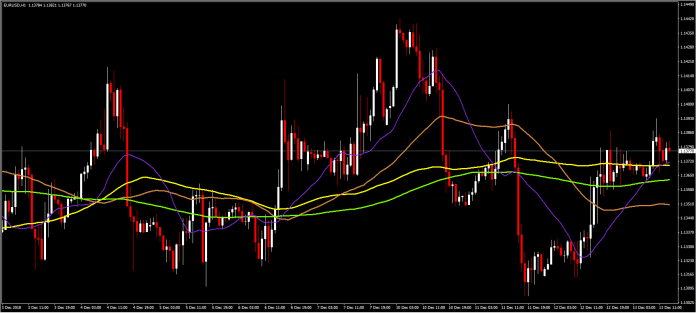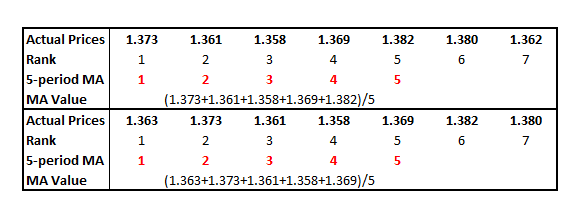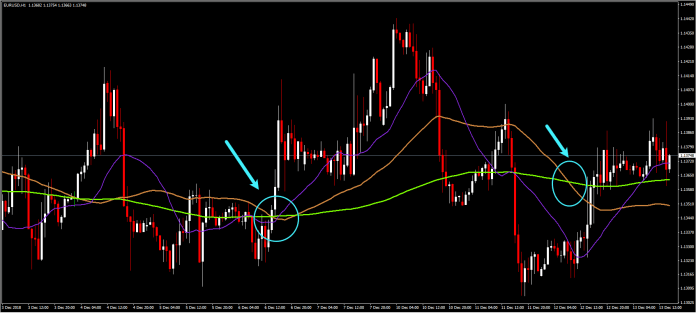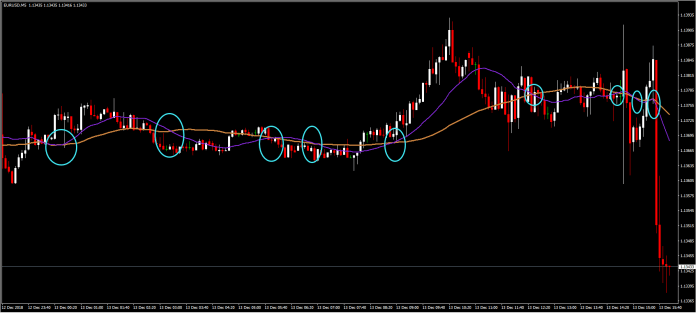This is the first of a two series post on Moving Averages. In this post, we introduce the notion of moving averages and then elaborate on how to compare their performance.
To begin with, Moving Averages (MAs) employ past price movements, usually the closing price, in order to smooth out any one-off erratic behaviour or unexpected/unexplained volatility (noise, as it also known) so that the user can see the trend more clearly. Put simply, a moving average simply averages the last values in a sequence of prices, depending on the length we choose. For example, a 9-period moving average would average the values of the last 9 periods, while a 20-period moving average would average the values of the last 20 periods.
The following table presents a short example of how a moving average works. The first box shows what the moving average value would have been at that specific point time. Notice that I am using a 5-period moving average in this example, which means that I am using the average of the last 5 prices of the currency pair (EURUSD in this case). Then, in the following box, we see that as another day elapsed, a new price came up (1.363), which pushed everything one position to the right. This means that the previous day’s price at rank #5 (1.382) has moved to rank number #6 and we will thus not use it in the calculation of the 5-period MA. This would mean that every period the price which was previously at number #5 will be scrapped, while a new price will enter at #1.
The analysis above is not limited to the 5-period case, but can be extended to any MA, from the fastest 3-period one to the longer-run 200-period MA. The difference between short- and long-term moving averages mainly lies in what we seek to study. As expected, the longer-term MAs tend to show us the longer-term trend, while short-term MAs allow for the examination of shorter-term movements in the price. Mathematically, this makes sense given that a new price in a 5-period moving average would receive a weight of 1/5, which is much bigger than 1/200 in the case of a 200-period moving average. A good example of short- and long-term moving averages can be seen in the first image of this post.
In particular, we see that the shorter-term MA (purple line), specified to have 20 periods, moves much faster than the longer-term MAs. As it appears, the 200-period MA (green line) and the 100-period MA (yellow line) tend to move much more slowly to changes in the price. The orange line, depicting the 50-period MA, moves in-between shorter and longer MAs. Naturally, other MAs also exist, with any possible number of periods being up for use.
To begin with, notice how using just long-term MAs would be pointless: the 200-period MA and the 100-period MA cross just once in 1-hour chart, with the cross not providing any meaningful sign as the two move more or less in parallel. In essence, what we would really like is for shorter-term MAs to cross longer-term MAs. For example, the 50-period MA, in combination with the 200-period MA issue much better signals in this chart. As the 50-period MA crosses the 200-period MA from below a sell sign is issued. The sign, in retrospect or backtesting if you prefer, appears to be correct, even though the sell sign issued later on does not work as expected. In particular, it appears that the sell sign would come too late, given that we would have already experienced losses at that point.
On the other hand, the 20-period moving average and the 50-period MA appear to work much better. As the picture suggests, the signals issued appear to be much more accurate, regarding the ongoing trend. Naturally, the signs do not provide support as to where the trading target should be, but we will leave that as a topic for a future post. Also note that the same MAs which offer good guidance for the 1-hour chart may prove problematic if employed at a different frequency.
The following chart illustrates the same two moving averages may not work so well for the 5-minute chart. The indicators, while correct for the larger movement in the middle of the chart, show too many false crossing signs which would lead to losses. This is most likely because the frequency is too high for the averages to reach proper levels. As such, one should remember that we need to backtest our moving average selection before committing ourselves to a trade. Thus, in the second part we will deal with shorter-term MAs and have a look as to how these can be used for other frequencies.
Disclaimer: Nothing in this communication contains, or should be considered as containing, an investment advice or an investment recommendation or a solicitation for the purpose of purchase or sale of any financial instrument.
Recommended Content
Editors’ Picks

EUR/USD consolidates weekly gains above 1.1150
EUR/USD moves up and down in a narrow channel slightly above 1.1150 on Friday. In the absence of high-tier macroeconomic data releases, comments from central bank officials and the risk mood could drive the pair's action heading into the weekend.

GBP/USD stabilizes near 1.3300, looks to post strong weekly gains
GBP/USD trades modestly higher on the day near 1.3300, supported by the upbeat UK Retail Sales data for August. The pair remains on track to end the week, which featured Fed and BoE policy decisions, with strong gains.

Gold extends rally to new record-high above $2,610
Gold (XAU/USD) preserves its bullish momentum and trades at a new all-time high above $2,610 on Friday. Heightened expectations that global central banks will follow the Fed in easing policy and slashing rates lift XAU/USD.

Week ahead – SNB to cut again, RBA to stand pat, PCE inflation also on tap
SNB is expected to ease for third time; might cut by 50bps. RBA to hold rates but could turn less hawkish as CPI falls. After inaugural Fed cut, attention turns to PCE inflation.

Bank of Japan set to keep rates on hold after July’s hike shocked markets
The Bank of Japan is expected to keep its short-term interest rate target between 0.15% and 0.25% on Friday, following the conclusion of its two-day monetary policy review. The decision is set to be announced during the early Asian session.

Moneta Markets review 2024: All you need to know
VERIFIED In this review, the FXStreet team provides an independent and thorough analysis based on direct testing and real experiences with Moneta Markets – an excellent broker for novice to intermediate forex traders who want to broaden their knowledge base.




